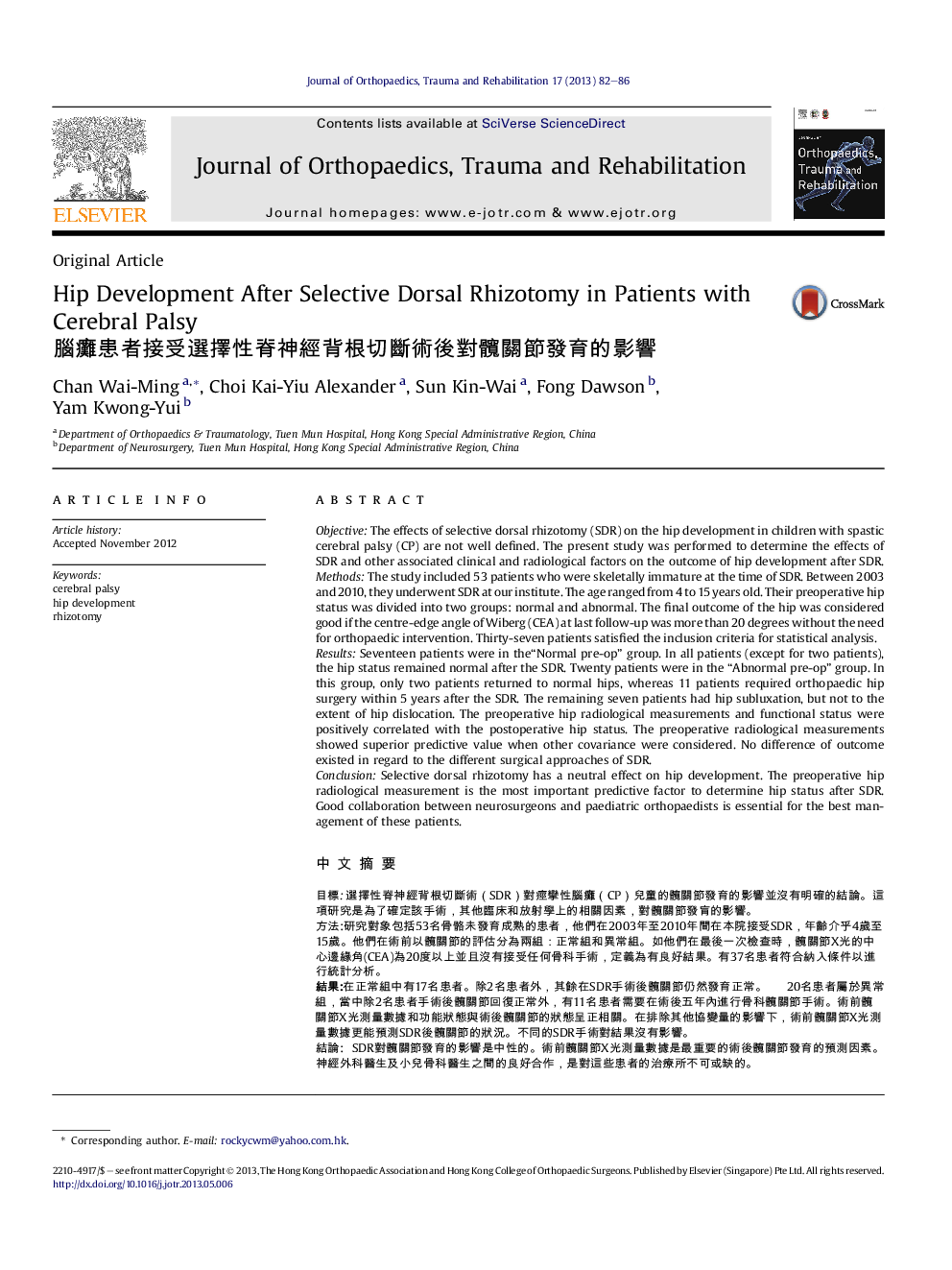| کد مقاله | کد نشریه | سال انتشار | مقاله انگلیسی | نسخه تمام متن |
|---|---|---|---|---|
| 4072640 | 1266956 | 2013 | 5 صفحه PDF | دانلود رایگان |

ObjectiveThe effects of selective dorsal rhizotomy (SDR) on the hip development in children with spastic cerebral palsy (CP) are not well defined. The present study was performed to determine the effects of SDR and other associated clinical and radiological factors on the outcome of hip development after SDR.MethodsThe study included 53 patients who were skeletally immature at the time of SDR. Between 2003 and 2010, they underwent SDR at our institute. The age ranged from 4 to 15 years old. Their preoperative hip status was divided into two groups: normal and abnormal. The final outcome of the hip was considered good if the centre-edge angle of Wiberg (CEA) at last follow-up was more than 20 degrees without the need for orthopaedic intervention. Thirty-seven patients satisfied the inclusion criteria for statistical analysis.ResultsSeventeen patients were in the“Normal pre-op” group. In all patients (except for two patients), the hip status remained normal after the SDR. Twenty patients were in the “Abnormal pre-op” group. In this group, only two patients returned to normal hips, whereas 11 patients required orthopaedic hip surgery within 5 years after the SDR. The remaining seven patients had hip subluxation, but not to the extent of hip dislocation. The preoperative hip radiological measurements and functional status were positively correlated with the postoperative hip status. The preoperative radiological measurements showed superior predictive value when other covariance were considered. No difference of outcome existed in regard to the different surgical approaches of SDR.ConclusionSelective dorsal rhizotomy has a neutral effect on hip development. The preoperative hip radiological measurement is the most important predictive factor to determine hip status after SDR. Good collaboration between neurosurgeons and paediatric orthopaedists is essential for the best management of these patients.
中文摘要目標選擇性脊神經背根切斷術(SDR)對痙攣性腦癱(CP)兒童的髖關節發育的影響並沒有明確的結論。這項研究是為了確定該手術,其他臨床和放射學上的相關因素,對髖關節發肓的影響。方法:研究對象包括53名骨骼未發育成熟的患者,他們在2003年至2010年間在本院接受SDR,年齡介乎4歲至15歲。他們在術前以髖關節的評估分為兩組:正常組和異常組。如他們在最後一次檢查時,髖關節X光的中心邊緣角(CEA)為20度以上並且沒有接受任何骨科手術,定義為有良好結果。有37名患者符合納入條件以進行統計分析。結果:在正常組中有17名患者。除2名患者外,其餘在SDR手術後髖關節仍然發育正常。 20名患者屬於異常組,當中除2名患者手術後髖關節回復正常外,有11名患者需要在術後五年內進行骨科髖關節手術。術前髖關節X光測量數據和功能狀態與術後髖關節的狀態呈正相關。在排除其他協變量的影響下,術前髖關節X光測量數據更能預測SDR後髖關節的狀況。不同的SDR手術對結果沒有影響。結論: SDR對髖關節發育的影響是中性的。術前髖關節X光測量數據是最重要的術後髖關節發育的預測因素。神經外科醫生及小兒骨科醫生之間的良好合作,是對這些患者的治療所不可或缺的。
Journal: Journal of Orthopaedics, Trauma and Rehabilitation - Volume 17, Issue 2, December 2013, Pages 82–86